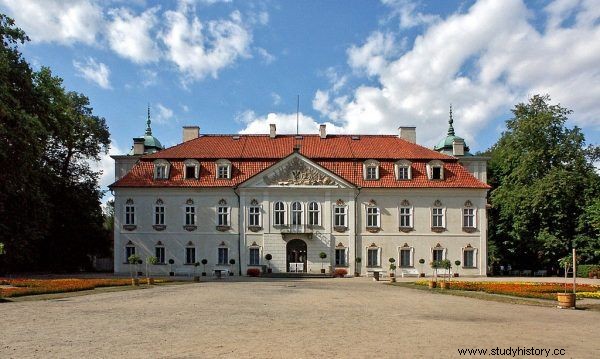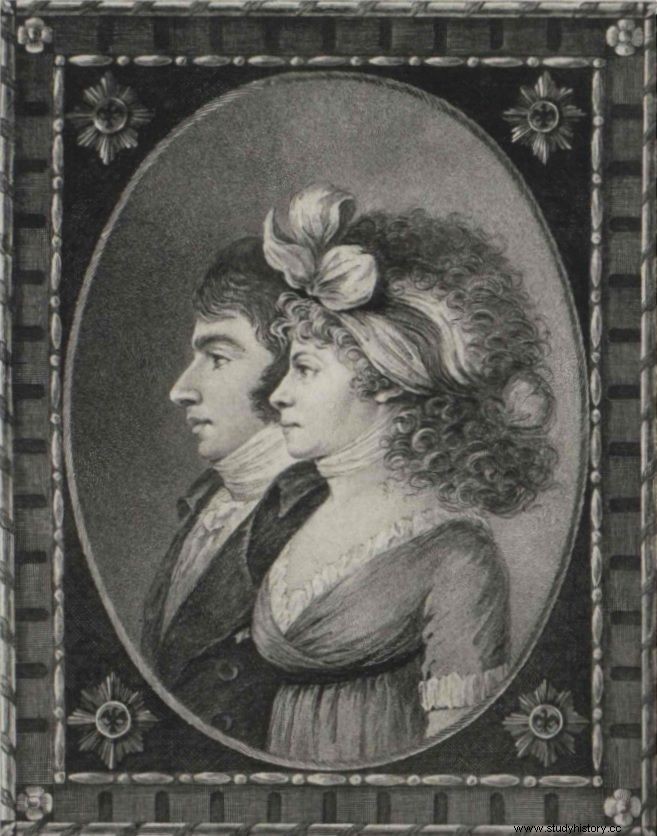When the Commonwealth was wiped off the maps of Europe, he was brilliant at the court of the Prussian king, and his wife gossiped with Tsarina Catherine II like her best friend. This sybarite and traitor did not hesitate to sacrifice his homeland in order to be able to buy another fig tree ...
The man in question, along with the Marshal of the Partition Sejm, Adam Poniński, played a shameful role in Polish history. On September 18, 1773, he signed treaties on the assignment of the territories of the Polish-Lithuanian Commonwealth to Russia, Prussia and Austria. And he did it solely for his own benefit.
As a reward, he received the starosties of:Grabowski, Bolimów and Borysów, the Vilnius castellany, and in 1790 he was appointed the Vilnius voivode. The last one in the history of the First Republic of Poland. Who are we talking about? Who deserved to be called one of the greatest traitors in our history?
A member of one of the most powerful Polish families:Michał Hieronim Radziwiłł - classic sybarite and bon vivant who stuck with his bleached blonde wig. Mandatory for all official occasions.
Radziwiłł - rich and mad
The estates that the prince added to his estate as a gratification for supporting the partition is one thing. The money he took from the partitioning powers was even more embarrassing. Among other things, collected a thousand ducats a month for "negotiating" a trade treaty unfavorable for Poland with Prussia . Thanks to this, and other similar injections of cash, he acquired wonderful Nieborów goods.

The Partition Sejm of 1773-1775 was appointed by the three partitioning powers to approve the cession of the territory of the Republic of Poland during its first partition. Michał Hieronim Radziwiłł's attitude was opposite to that of Rejtan, recorded in Jan Matejko's painting.
Can you find anything to defend Michał Hieronim? Probably just that, unlike many other members of the family, he did not waste his fortune. On the contrary, he diligently multiplied his fortune! He founded manufactories, introduced efficient administration. The host is modern, based on English patterns. It was not a common practice for the Radziwiłłs of those times.
The symptoms of the Radziwiłł tree's deterioration were twofold:first, they stopped reproducing:some died at a young age, others left the world childless, although they had the habit of “marrying” two or three times. The second symptom was the appearance of the original Radziwiłłs, freaks, mentally handicapped or, in the midst of unbridled frolics, reaching cruelty . There must have been a lot of them, when the "fame" of some of them spread widely throughout Poland and passed to posterity - wrote the historian and journalist, Kazimierz Bartoszewicz.
Witold Banach, in his book Radziwiłłów. The stormy fate of the famous family ", one of the heroes of which is Michał Hieronim, many times recalls the classic work of Stanisław Cat-Mackiewicz" The House of the Radziwiłł ". According to this author, the "difficult cases" of the family were to be the result of the decadence to which all of Europe was undergoing, and the Polish aristocracy with unparalleled power than any other.
Instead of the great statesmen, which she undoubtedly gave birth to in previous centuries, especially in the sixteenth century (...), she begins to produce decadent, decadent figures; In previous centuries, the Radziwiłłs created, represented or at least defended the greatness of the state. Now they will illustrate his fall - Cat-Mackiewicz argued.

Michał Hieronim Radziwiłł was "lucky in misfortune" in his childhood. As the son of a madman (in the picture on the left, Michał's father - Marcin Mikołaj), he was taken into the care of a relative called "Rybeńka" (on the right), the richest at that time of the entire Radziwiłł family. Perhaps it was from him that he took his enormous love of money ...
A good farmer with no patriotism
Against this background, our prince, though stripped of his Polish identity, looks pretty good. Especially for the son of the crazy Marcin Mikołaj Radziwiłł, who was incapacitated in 1748, when Michał Hieronim was only four years old. The boy was taken care of by his relative, Michał Kazimierz Radziwiłł "Rybeńka", the richest man in the whole family at that time - the ordinate of Niewiedzski, Ołycki and the lord of Biała.
Under the tutelage of a wealthy relative, Michaś received a thorough education, which paid off in the future. In his mature age, he was able to take care of business. Take, for example, his estates near Kalisz. The latifundium consisted of five so-called keys, which included 22 villages, several farms and the town of Ostrów, which is an important center of weaving and cloth production in Wielkopolska. Witold Banach in the book “Radziwiłłów. The turbulent fate of the famous family ”he writes:
The Przygodzice estate was famous for its fish ponds, the largest in the Commonwealth and the leading one in Europe - included 118 ponds and ponds, including 18 the largest with a total area of about 700 hectares . The assets of Przygodzice brought PLN 63,000 a year, including PLN 16,000 from the fishing industry.

The palace in Nieborów belonged to the Radziwiłł family from 1774 to 1944. It was Michał Hieronim who gathered there a famous rich collection of paintings, and his wife dealt with stylish interior decoration. And all this for money from the partitioning powers…
What he was spending a fortune on
Most of the profits derived from the betrayal of Polish interests and the income from latifundia were spent by Michał Hieronim on his family seat in Nieborów near Łowicz. He brought there English furniture, porcelain and silver, and amassed a collection of paintings, old coins and medals. He arranged a library with thousands of old prints, prints and maps. During the Great French Revolution, he bought valuable books from the collections of Louis XIV, Cardinal Richelieu, Marie Antoinette and Madame de Pompadour.
The nearby Arkadia landscape park was the apple of the prince's eye, Helena née Przezdziecki, who successfully competed with Izabela Czartoryska and her Puławy. Hundreds of fig trees, flowering lemon and orange trees in an impressive conservatory and an exquisite English park layout even poets sang. Not to mention, of course, the sources of funds for the purchase of another fig tree.

The wedding of Michał Hieronim's son cost him dearly not only himself, but also his son. According to the contract, Antoni Henryk was not allowed to leave Prussia. But what a sacrifice it was, when he got 30,000 a year from his father ... Illustrated by Antoni Henryk Radziwiłł with his wife Luiza.
The next "investment" of the princely couple was the marriage of their son - Antoni Henryk Radziwiłł - to Luiza Fryderyka née Hohenzollern, niece of the Prussian king Frederick II the Great. Since such connections had to cost, the father undertook to pay his son an astronomical amount of 30,000 thalers a year (i.e. about 180,000 zlotys at that time) and additionally - as a wedding gift - he bought the newlyweds the baroque Schulenburg Palace at 77 Wilhelmstrasse in Berlin. This building became the seat of the Berlin Radziwiłł line for 80 years.
A hair from the noose
During the session of the Four-Year Seym, Duke Michał Hieronim, of course, joined the conservative party. He was a staunch opponent of the May 3rd Constitution and joined the Targowica Confederation. On her behalf, he became the chairman (or gravedigger) of the National Education Commission - Witold Banach writes in the book Radziwiłłów. The stormy fate of the famous family ”, suggesting that Radziwiłł remained in the paid services of Frederick II. This is probably why in 1791 he became a Knight of the Prussian Order of the Black Eagle.
He was the only Polish voivode to sign treaties with Russia and Prussia in 1793, agreeing to the second partition of the country and in the same year he hosted a new Prussian king in Nieborów, Frederick William II, who was touring the seized lands.
He safely survived the Kościuszko Uprising. Like the leading residents of Target:Stanisław Szczęsny Potocki, Franciszek Ksawery Branicki and Seweryn Rzewuski - Michał Hieronim Radziwiłł avoided being hanged. He was in St. Petersburg at that critical moment.
Through the bed to riches
What about his lifelong partner? When they got married in 1771, she was only 18 years old, he was already a mature 28-year-old man. Apparently, however, it was Helena who chose Michał Hieronim as her husband. The beauty of the young heiress of Przezdziecki was celebrated throughout the kingdom. She was also blessed with artistic talents, she was fluent in French, English, German and Italian. Meanwhile, she knew the Polish language the least.

Helena Radziwiłł née Przezdziecki was a lady of the court of Tsarina Catherine II. Despite the fact that she married Michał Hieronim, she still got into numerous affairs, incl. from St. August Poniatowski. The husband, however, tolerated his wife's offenses because they brought him both political and material benefits. The illustration shows a portrait of Helena by Ernst Gebauer (1816).
The young prince Radziwiłł was also handsome, and in the spirit of the era, he and his wife were looking for erotic adventures outside of marriage. Michał Hieronim tolerated Helena's famous romances, taking advantage of them. This particularly concerned the eight-year intimacy of the prince's wife with the Russian ambassador Stackelberg, and later with the British envoy in Warsaw, Count Charles Whitworth. Another chosen one of the duchess was Jakob Johann Sievers, the deputy of Catherine II, whose only task in Poland was to carry out the second partition.
The resident of Targowicz, Michał Hieronim Radziwiłł, lived for over 86 years. In exchange for the money of the partitioning powers and the acquired land estates, he wrote off the Commonwealth. He was the extreme opposite of Prince Józef Poniatowski. From the Russian frosts and the treacherous current of Elster, he preferred a comfortable life in Nieborów and fraternizing with the Hohenzollerns and the Romanovs.
